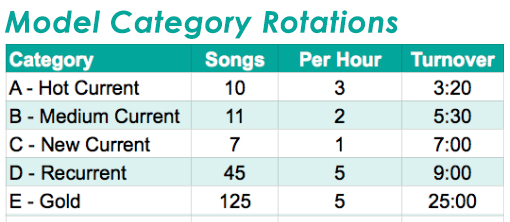In order create the best playlist possible, it’s important to categorize each song in your music library. The sample music structure we’ll examine here will be contemporary music (like top 40, country, hip hop, and alternative), but the category structure can apply to all genres with just a few tweaks.
There are three general categories:
Currents are the newest songs that are still on their way up the charts. They can be the newest hits or even hits that are a little bit older, but still at their peak.
Recurrents are recent hits that are past their prime (six months to two years old). They’re the opposite of currents- they’re on their way down the charts -but still essential and important to listeners.
Gold/Oldies are older hits (more than two years) that the audience still enjoys. How far back these songs go depends on the station. For top 40 stations, songs usually go back around five years, but no more than 10 years. Country, adult contemporary, and the likes can range anywhere from 20 to 30 years back. Oldies and classic rock stations are- you guessed it -all gold!

Above is an example chart of a contemporary music station’s category rotation. Because this example is for a station that plays newer music (rather than a classic rock station), you’ll see the Current category is broken into three categories (hot, medium, and new), along with the original Recurrent and Gold categories.
In the above example, songs refers to the number of songs in the library per category, per hour refers to how many times a song from that category could be played per hour, and turnover is the individual song rotation measured in hours:minutes until that exact song could be played next.
The three general categories can then be broken into:
Hot Current
Hot Currents are the biggest hits and receive the fastest rotation. Songs rarely start out in this category. Rather, newer songs tend to start out in New Current or occasionally Medium Current. To make their way up the ranks, songs need to deem themselves worthy.
Medium Current
Songs in the Medium Current category receive the second fastest rotation right after Hot Current. Occasionally, songs can start out in this category, but it’s not often. If they do start out here, they’re usually new songs from already popular artists. The majority of songs in this category have moved their way up from the New Current category.
New Current
New Current songs are new songs from new artists. If the song is a hit with a station’s audience, it can move up to the Medium Current and eventually Hot Current categories. However, not all songs move up. This can be a song’s first and only category. If the song isn’t a hit, it should be removed from the rotation overall.
Recurrent
Beloved songs from the Hot Current category will bump to this Recurrent category once the novelty wears off, often after a few weeks. Not every song will get thrown back into rotation in this category, just the best of the best. These songs will stay in this category anywhere from six months to two years.
Gold
Gold, otherwise known as Oldies, are the best of the best of the once greatest hits coming from the Recurrent category. They stay in rotation in this category for two to ten years. (For oldies stations: Since all songs would fall in this Gold category, you can categorize by eras or decades.)
It’s important to note that due to the DMCA, internet radio stations need to be careful with how often they repeat songs and artists. To read more about the DMCA, click here.
For more information on programming your station, see our article on music selection and playlist creation.
Discover thousands of free stations from every genre of music and talk at live365.com/listen. Keep up with the latest news by following us on Facebook (Live365 Official and Live365 Broadcasting) and Twitter (@Live365 and @Broadcaster365)!
Article Image: Pexels via Pixabay.

